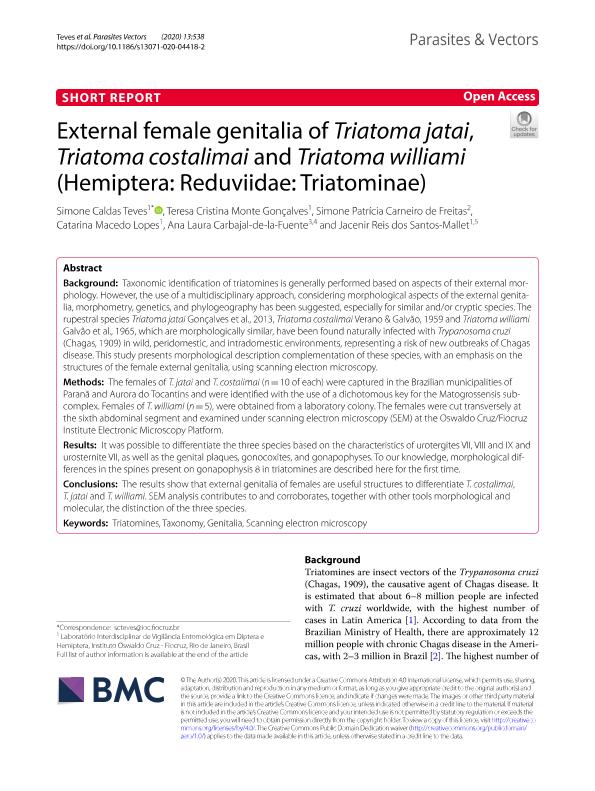Artículo
External female genitalia of Triatoma jatai, Triatoma costalimai and Triatoma williami (Hemiptera: Reduviidae: Triatominae)
Caldas Teves, Simone; Monte Gonçalves, Teresa Cristina; Carneiro de Freitas, Simone Patrícia; Macedo Lopes, Catarina; Carbajal de la Fuente, Ana Laura ; Reis dos Santos Mallet, Jacenir
; Reis dos Santos Mallet, Jacenir
 ; Reis dos Santos Mallet, Jacenir
; Reis dos Santos Mallet, Jacenir
Fecha de publicación:
11/2020
Editorial:
BioMed Central
Revista:
Parasites and Vectors
ISSN:
1756-3305
Idioma:
Inglés
Tipo de recurso:
Artículo publicado
Clasificación temática:
Resumen
Background: Taxonomic identification of triatomines is generally performed based on aspects of their external morphology. However, the use of a multidisciplinary approach, considering morphological aspects of the external genitalia, morphometry, genetics, and phylogeography has been suggested, especially for similar and/or cryptic species. The rupestral species Triatoma jatai Gonçalves et al., 2013, Triatoma costalimai Verano & Galvão, 1959 and Triatoma williami Galvão et al., 1965, which are morphologically similar, have been found naturally infected with Trypanosoma cruzi (Chagas, 1909) in wild, peridomestic, and intradomestic environments, representing a risk of new outbreaks of Chagas disease. This study presents morphological description complementation of these species, with an emphasis on the structures of the female external genitalia, using scanning electron microscopy. Methods: The females of T. jatai and T. costalimai (n = 10 of each) were captured in the Brazilian municipalities of Paranã and Aurora do Tocantins and were identified with the use of a dichotomous key for the Matogrossensis subcomplex. Females of T. williami (n = 5), were obtained from a laboratory colony. The females were cut transversely at the sixth abdominal segment and examined under scanning electron microscopy (SEM) at the Oswaldo Cruz/Fiocruz Institute Electronic Microscopy Platform. Results: It was possible to differentiate the three species based on the characteristics of urotergites VII, VIII and IX and urosternite VII, as well as the genital plaques, gonocoxites, and gonapophyses. To our knowledge, morphological differences in the spines present on gonapophysis 8 in triatomines are described here for the first time. Conclusions: The results show that external genitalia of females are useful structures to differentiate T. costalimai, T. jatai and T. williami. SEM analysis contributes to and corroborates, together with other tools morphological and molecular, the distinction of the three species.
Palabras clave:
GENITALIA
,
SCANNING ELECTRON MICROSCOPY
,
TAXONOMY
,
TRIATOMINES
Archivos asociados
Licencia
Identificadores
Colecciones
Articulos(SEDE CENTRAL)
Articulos de SEDE CENTRAL
Articulos de SEDE CENTRAL
Citación
Caldas Teves, Simone; Monte Gonçalves, Teresa Cristina; Carneiro de Freitas, Simone Patrícia; Macedo Lopes, Catarina; Carbajal de la Fuente, Ana Laura; et al.; External female genitalia of Triatoma jatai, Triatoma costalimai and Triatoma williami (Hemiptera: Reduviidae: Triatominae); BioMed Central; Parasites and Vectors; 13; 1; 11-2020; 1-6
Compartir
Altmétricas



